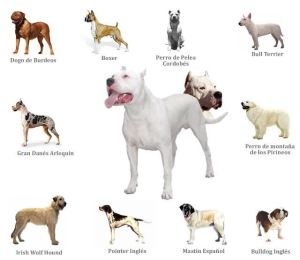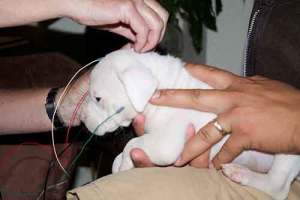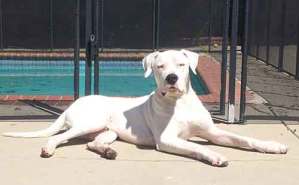Dogo Argentino
The Dogo Argentino
The Dogo Argentino is a pack-hunting dog, bred for the pursuit of big-game such as wild boar and puma, and possesses the strength, intelligence and quick responsiveness of a serious athlete. His short, plain and smooth coat is completely white, but a dark patch near the eye is permitted as long as it doesn’t cover more than 10% of the head.
Our Dogo, Luna, is the daughter of the legendary Morocho
Breed Information
-
History
This breed has its origin in the province of Cordoba, in the central (Mediterranean) region of the Republic of Argentina.

Its creator was Dr. Antonio Nores Martinez, a (renowned) doctor and member of a traditional family. In 1928, his passion for dogs, perhaps a family legacy, led him to set the bases and a standard for a new dog breed which he named Dogo Argentino. His work was based upon the methodical crossbreeding of several purebreds with the old fighting dog from Cordoba, a dog which was very strong and vigorous. After a thorough and minute character study and selection, through different generations, Dr. Nores Martinez accomplished his purpose, obtaining the first family. At the beginning it was generally considered a dog for fighting but Dr. Nores Martinez’s liking for hunting led him to take the dog to one of his habitual hunting trips, where the new breed demonstrated its skills, thus becoming a key figure in all his trips. Thus it became quickly an excellent big-game hunting dog.
With the passing of time, this adaptating capacity has made this dog very versatile as regards functions; it has proved to be a noble companion and a loyal and insurmountable protector of those it loves. Its strength, tenacity, sharp sense of smell and bravery make it the best dog among those used for hunting wild boars, peccaries, pumas and other country predators which can be found in the vast and heterogeneous areas of the Argentinean territory. Its harmony, balance and its excellent athletic muscles are ideal characteristics for enduring long trips in any weather conditions and then fighting fiercely with the pursued prey.
In 1973 the breed was accepted by FCI as the first and only Argentinean breed, thanks to the great passion, work and effort of Dr. Augustin Nores Martinez, its creator’s brother and successor.
Source: www.akc.org
© The American Kennel Club, Inc. -
Feeding
Feed your Dogo Argentino puppy twice a day. We recommend that you choose a brand suitable for “giant breeds” as well as for puppies (“growth” life-stage). Dogos grow very rapidly. They require a certain amount of nutrition in order to grow healthy. After 7-8 weeks, they can eat hard kibble, which is best for them.
We strongly recommend that you choose a dog food that is certified by AAFCO (Association of American Feed Control Officials). AAFCO is a non-profit organization that sets standards for both animal feeds and pet foods in the United States. In order for a dog food to be marketed as “complete and balanced”, it must meet the nutritional standards established by AAFCO. It will say something to the effect of : “(Name of product) is formulated to meet the nutritional levels established by the AAFCO Dog Food Nutrient Profiles” or “Animal feeding tests using AAFCO procedures substantiate that (name of product) provides complete and balanced nutrition”.
For your puppy, you will want a food that states it is suitable for “growth” life stages. Any AAFCO approved dog food suitable for “all life stages” is also suitable for puppies, too. The brand of food that we feed our Dogos is called “Taste of the Wild” and it is widely available. It is suitable for puppies and adults as well as almost all breeds. It is highly nutritious and protein-based. However, we do not recommend any specific brand; only that you provide a healthy one.
The important thing to remember is not to change food too often. Changing the food can cause gastrointestinal distress, gas, bloating and diarrhea in your dog. It is best to choose one brand and stick with it. When you first take your puppy home, be aware that they may have a small amount of gastrointestinal distress for the first few days since they are most likely changing their brand of food. If this is due to diet change, it should resolve without additional treatment; but make sure to keep them well hydrated. However, if it lasts any longer than a few days or is more than just very mild, be sure to see your vet to have your pup checked out to be sure.
Give your Dogo plenty of water. We recommend leaving a bucket of clean water available all day; they often drink more water than you would expect.
While your Dogo is a puppy, be sure to play with him/her while they are eating. Mess around with them a little and let them get used to you moving their food around. Touch both the puppy and the food. Any dog has a natural instinct to be aggressive to anyone who touches their food. But if you train them from a puppy that people will be touching their food, there is a much better chance that they will not be aggressive as an adult. If you have children, help them to touch the puppy while they are eating when the puppy is very small. You must train the puppy to let people, especially children to be around its food.
-
Sun Protection
Dogos have very little pigment in their skin. They can be very susceptible to sunburn, especially as puppies. If they get very sunburned, they can also scab. Very susceptible parts are the tops of their ears and head and places where the fur is very thin. Make sure your puppy has lots of shade available all day to him/her. In addition, you can buy dog sunscreen products at any vet or pet store. The other thing that works well is to let them stay relatively dirty and not wash them too often. It can be very tempting to wash your white dog almost daily at times– believe us, we understand! But the dirt can act as a natural sunscreen for your dog and keep him from getting burned. Dogs are like people in this way and can get skin cancer from too much sun exposure. Also, you may notice that after you bathe your dog, he/she wants to immediately roll in the dirt. It’s their natural instinct to protect their skin in this way, even though it can be frustrating for the owner! They are just trying to protect themselves.
-
Deaf Dogos

All of our puppies are BAER tested. BAER stands for “Brainstem Auditory Evoked Response”. This is a test for both ears to show if they respond to sound correctly as they should. We will let you know immediately if anything of concern comes up with your puppy’s BAER test. In addition, you will receive a copy of your puppy’s results when you take him/her home. A specialist from the UC Davis Electrophysiology Lab tests all of our puppies. If you have any further questions about the results, or would like to speak with our vet specialist, please let us know.
“We love our Dogo Kingston. He is a Uni and we could never tell if we didn’t know. There is absolutely no difference in trainability temperament functionality or personality.

Kingston He is amazing with kids, a loving dog and one of the best looking Dogo’s we’ve seen. It would be a shame to miss out on this great dog because we were worried about him only being able to hear in one year.
Just remember your dogs one good ear is 1000 times better than both of yours!!!”
–The Hamiltons, owners of Kingston,
a “uni” from Dogos De Maravilla.Having a deaf dog can be very rewarding as well. Just because a dog is deaf does not mean that he/she cannot be trained. We have seen amazing results from dogs who are completely deaf. It tends to enhance their other senses and sometimes make up for them.
While we do test all of our puppies, that just helps us to fit the dog to the best owner. The more knowledge an owner has of their dog before they bring them home, the better. The BAER test is just more information about how this dog needs to be treated and trained. For example, you wouldn’t want a fully deaf dog as a guard dog. But a partially deaf dog could possibly be great in this role.
In general, we do not like to breed any dog that is partially or fully deaf. They do, however, make the sweetest pets in the world, and the owners who have these dogs from our kennel are very happy. We usually charge much less for a puppy who has not “passed” their BAER test. This can often mean that they are only partially deaf in one ear; something you may never have noticed if you never tested them. It can be a way to take home a puppy for a lower price.
-
Socialization & Training
All of our Dogos are very socialized. They have been around children and other dogs daily. If you would like to continue to socialize your puppy, be sure to have children and other dogs around. Walk your dog outside during the day when there are other people and dogs out. Bring other dogs around to your house. Puppy classes can also be a great socialization tool. You can even find puppy “daycares” in some areas.
Ideally, you should not take your puppy out on walks, to dog parks or around other dogs until they are fully vaccinated (around 16 weeks). This is due to the risk of acquiring diseases like Parvo, which can live in the environment for a long time, and can be deadly to a young pup.
Dogos are naturally great with kids. They are gentle and kind and have loving temperaments. However, your Dogo will be very protective of you and your family. They will want to check out anyone that is near you and they will not appreciate anyone seeming to hurt you or your family.
Females tend to be a bit more active than males. In addition, they grow so quickly, they sometimes don’t have a sense of their own size until they are older. It’s not unusual for my 100 lb. Dogo to try to sit on my lap. So if you don’t want a 100 lb. dog on your couch, train your puppy from a very young age not to sit on the couch. Because before you know it, your tiny puppy has turned into a giant dog. You will be amazed!